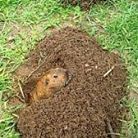Gopher Removal
Gopher removal is one of the most commonly requested services we offer.
See below for more information on the physical description and behavioral traits of these animals. If you think you have one or more of these little guys living in your yard or on your business's grounds, contact us for your FREE gopher removal quote today! We are trusted throughout the Greater Tulsa area and the rest of Oklahoma as the go-to professionals for gopher removal.
See below for more information on the physical description and behavioral traits of these animals. If you think you have one or more of these little guys living in your yard or on your business's grounds, contact us for your FREE gopher removal quote today! We are trusted throughout the Greater Tulsa area and the rest of Oklahoma as the go-to professionals for gopher removal.

